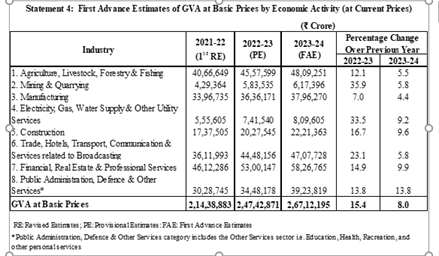Real GDP
Real gross domestic product (GDP) is GDP given in constant prices and refers to the volume level of GDP.
-
- Constant price estimates of GDP are obtained by expressing values of all goods and services produced in a given year, expressed in terms of a base period.
- Real gross domestic product (GDP) is an inflation-adjusted measure.
- Real GDP makes comparing GDP more meaningful because it shows comparisons for both the quantity and value of goods and services.
- It measures a country’s total economic output.

In India
-
- Base year for real GDP estimation is 2011-12.
- It is released by the Ministry of Statistics and Programme Implementation (MoSPI).
Nominal GDP
Nominal gross domestic product (GDP) is GDP given in current prices, without adjustment for inflation. Growing nominal GDP from year to year may reflect a rise in prices as well as growth in the number of goods and services produced (Price*Quantity).
Uses of nominal GDP
-
- It is an important metric to gauge inflation in the economy.
- It helps in estimating tax collection as tax revenues are estimated on current prices.
- It is a better indicator to compare economies as current prices are easily monitored and recorded.
- It represents an ease in accounting for cross border flow of capital.

Real GDP = Nominal GDP/ GDP Deflator
GDP Deflator: Normalising factor which is the ratio of nominal GDP and real GDP.
About GDP Deflator
-
- It is also called implicit price deflator.
- It covers the entire range of goods and services produced in the economy.
- GDP deflator is available only on a quarterly basis along with GDP estimates, whereas CPI and WPI data are released every month.
GDP at Purchasing Power Parity (PPP)
-
- It is a macroeconomic analysis metric used to compare economic productivity and standards of living between countries.
- It compares different countries’ currencies through a “basket of goods” approach.
- PPP is the exchange rate at which one nation’s currency would be converted into another to purchase the same and same amounts of a large group of products.
- If two countries are at Purchasing Power equilibrium, then nominal GDP is equal to the GDP (PPP).
Advantages of comparing GDP on Purchasing Power Parity
-
- Contribution of labour as factor of production is better captured
- Stable projections of GDP as exchange rate-based volatility are normalised
- Better indicator of wellbeing in an economy as it includes non-traded locally consumed goods and services.
Drawbacks of GDP at PPP
-
- Complex calculations as it is difficult to construct a standardised consumption basket of goods and services.
- Underestimation of productivity in the economy since labour intensive work is more valued.

